NSN431 Transforming Service: Advanced Independent Nursing Plan
VerifiedAdded on 2023/06/14
|21
|5902
|466
Report
AI Summary
This report presents a service improvement plan for Advanced Independent Nursing (AINP), building upon the existing Independent Nursing Practice (INP) model. It identifies various types of care provided by AINPs, including primary care, specialty care, home healthcare, health literacy support, and counseling services. The plan outlines strategies for care improvement, such as focusing on patient experiences, developing complex care plans, fostering partnerships, and promoting health literacy. Key enablers like information technology, service line operating models, and business planning are discussed, along with barriers such as opposition from general practitioners and funding challenges. The report also includes implementation and evaluation strategies to ensure the effectiveness of the AINP model in improving patient care and access to healthcare services. Desklib provides access to similar solved assignments and study resources for students.
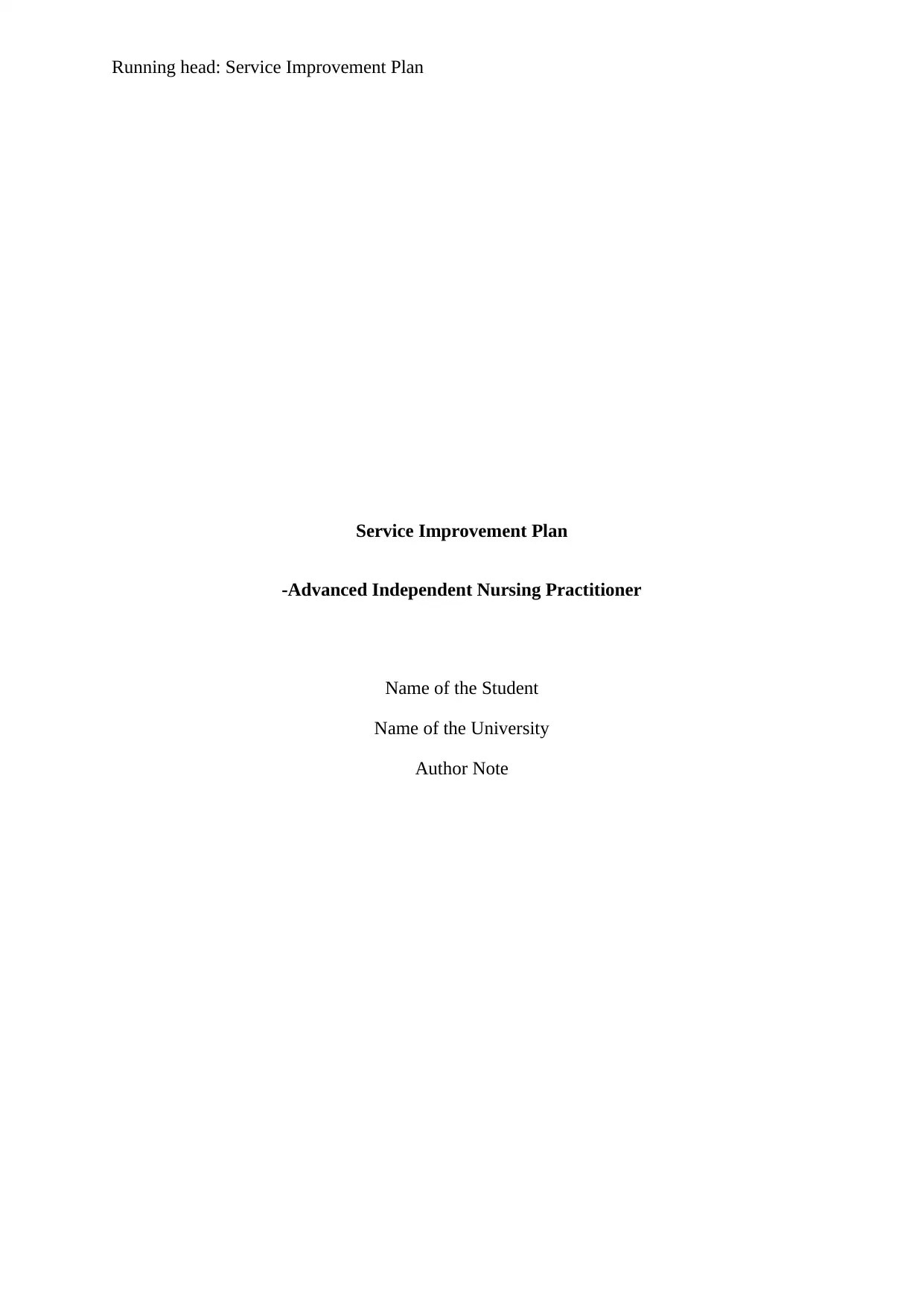
Running head: Service Improvement Plan
Service Improvement Plan
-Advanced Independent Nursing Practitioner
Name of the Student
Name of the University
Author Note
Service Improvement Plan
-Advanced Independent Nursing Practitioner
Name of the Student
Name of the University
Author Note
Paraphrase This Document
Need a fresh take? Get an instant paraphrase of this document with our AI Paraphraser
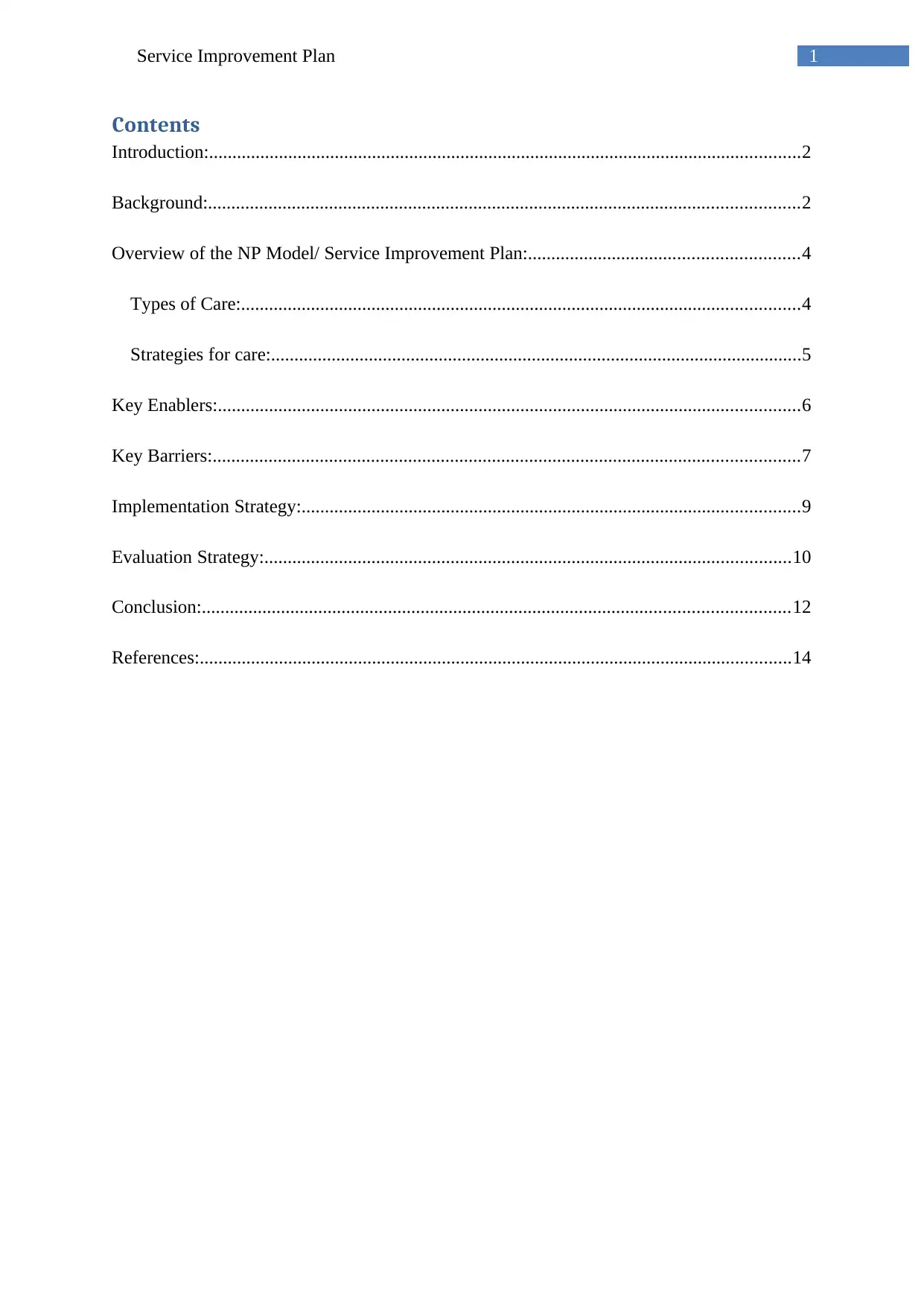
1Service Improvement Plan
Contents
Introduction:...............................................................................................................................2
Background:...............................................................................................................................2
Overview of the NP Model/ Service Improvement Plan:..........................................................4
Types of Care:........................................................................................................................4
Strategies for care:..................................................................................................................5
Key Enablers:.............................................................................................................................6
Key Barriers:..............................................................................................................................7
Implementation Strategy:...........................................................................................................9
Evaluation Strategy:.................................................................................................................10
Conclusion:..............................................................................................................................12
References:...............................................................................................................................14
Contents
Introduction:...............................................................................................................................2
Background:...............................................................................................................................2
Overview of the NP Model/ Service Improvement Plan:..........................................................4
Types of Care:........................................................................................................................4
Strategies for care:..................................................................................................................5
Key Enablers:.............................................................................................................................6
Key Barriers:..............................................................................................................................7
Implementation Strategy:...........................................................................................................9
Evaluation Strategy:.................................................................................................................10
Conclusion:..............................................................................................................................12
References:...............................................................................................................................14
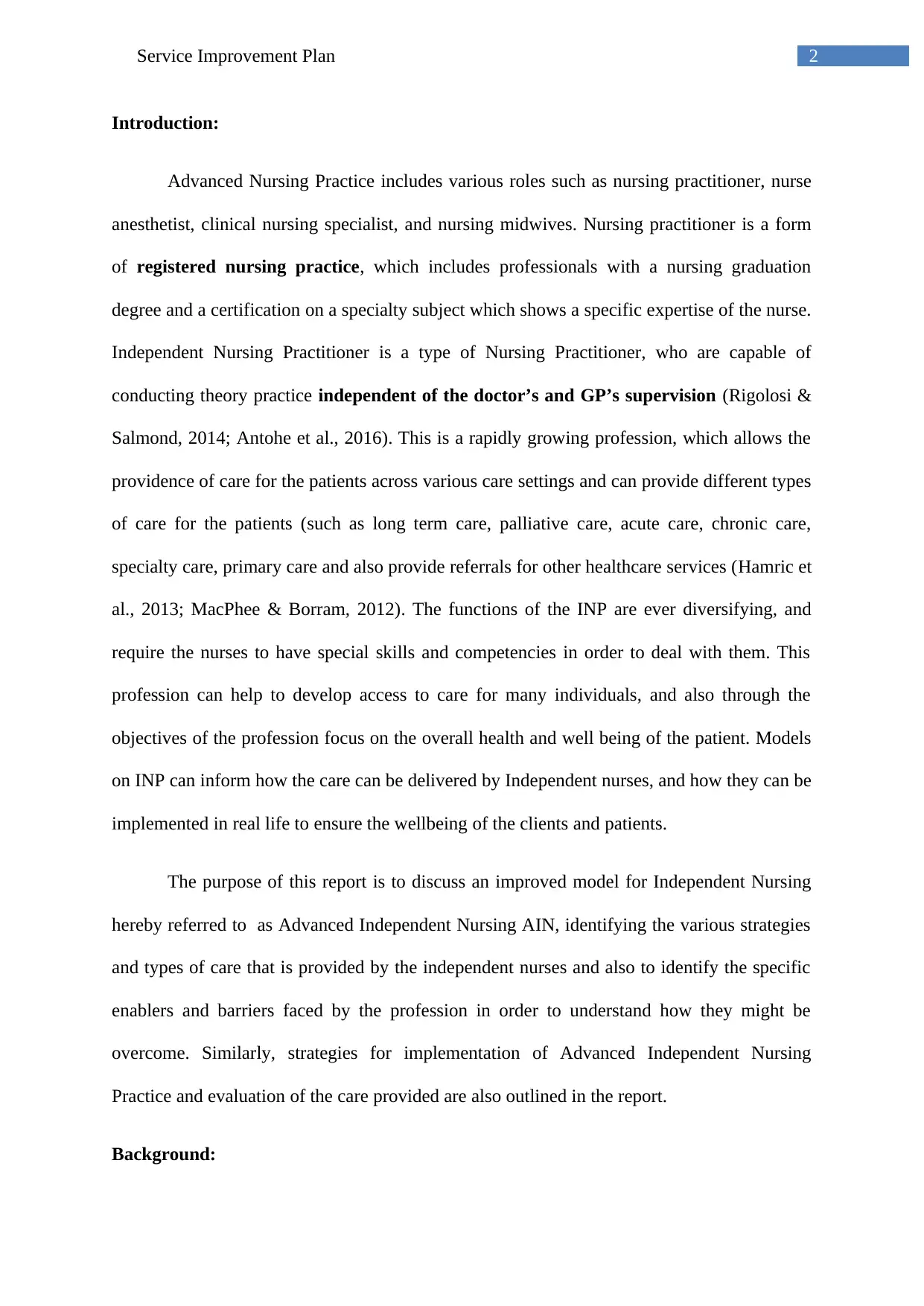
2Service Improvement Plan
Introduction:
Advanced Nursing Practice includes various roles such as nursing practitioner, nurse
anesthetist, clinical nursing specialist, and nursing midwives. Nursing practitioner is a form
of registered nursing practice, which includes professionals with a nursing graduation
degree and a certification on a specialty subject which shows a specific expertise of the nurse.
Independent Nursing Practitioner is a type of Nursing Practitioner, who are capable of
conducting theory practice independent of the doctor’s and GP’s supervision (Rigolosi &
Salmond, 2014; Antohe et al., 2016). This is a rapidly growing profession, which allows the
providence of care for the patients across various care settings and can provide different types
of care for the patients (such as long term care, palliative care, acute care, chronic care,
specialty care, primary care and also provide referrals for other healthcare services (Hamric et
al., 2013; MacPhee & Borram, 2012). The functions of the INP are ever diversifying, and
require the nurses to have special skills and competencies in order to deal with them. This
profession can help to develop access to care for many individuals, and also through the
objectives of the profession focus on the overall health and well being of the patient. Models
on INP can inform how the care can be delivered by Independent nurses, and how they can be
implemented in real life to ensure the wellbeing of the clients and patients.
The purpose of this report is to discuss an improved model for Independent Nursing
hereby referred to as Advanced Independent Nursing AIN, identifying the various strategies
and types of care that is provided by the independent nurses and also to identify the specific
enablers and barriers faced by the profession in order to understand how they might be
overcome. Similarly, strategies for implementation of Advanced Independent Nursing
Practice and evaluation of the care provided are also outlined in the report.
Background:
Introduction:
Advanced Nursing Practice includes various roles such as nursing practitioner, nurse
anesthetist, clinical nursing specialist, and nursing midwives. Nursing practitioner is a form
of registered nursing practice, which includes professionals with a nursing graduation
degree and a certification on a specialty subject which shows a specific expertise of the nurse.
Independent Nursing Practitioner is a type of Nursing Practitioner, who are capable of
conducting theory practice independent of the doctor’s and GP’s supervision (Rigolosi &
Salmond, 2014; Antohe et al., 2016). This is a rapidly growing profession, which allows the
providence of care for the patients across various care settings and can provide different types
of care for the patients (such as long term care, palliative care, acute care, chronic care,
specialty care, primary care and also provide referrals for other healthcare services (Hamric et
al., 2013; MacPhee & Borram, 2012). The functions of the INP are ever diversifying, and
require the nurses to have special skills and competencies in order to deal with them. This
profession can help to develop access to care for many individuals, and also through the
objectives of the profession focus on the overall health and well being of the patient. Models
on INP can inform how the care can be delivered by Independent nurses, and how they can be
implemented in real life to ensure the wellbeing of the clients and patients.
The purpose of this report is to discuss an improved model for Independent Nursing
hereby referred to as Advanced Independent Nursing AIN, identifying the various strategies
and types of care that is provided by the independent nurses and also to identify the specific
enablers and barriers faced by the profession in order to understand how they might be
overcome. Similarly, strategies for implementation of Advanced Independent Nursing
Practice and evaluation of the care provided are also outlined in the report.
Background:
⊘ This is a preview!⊘
Do you want full access?
Subscribe today to unlock all pages.

Trusted by 1+ million students worldwide
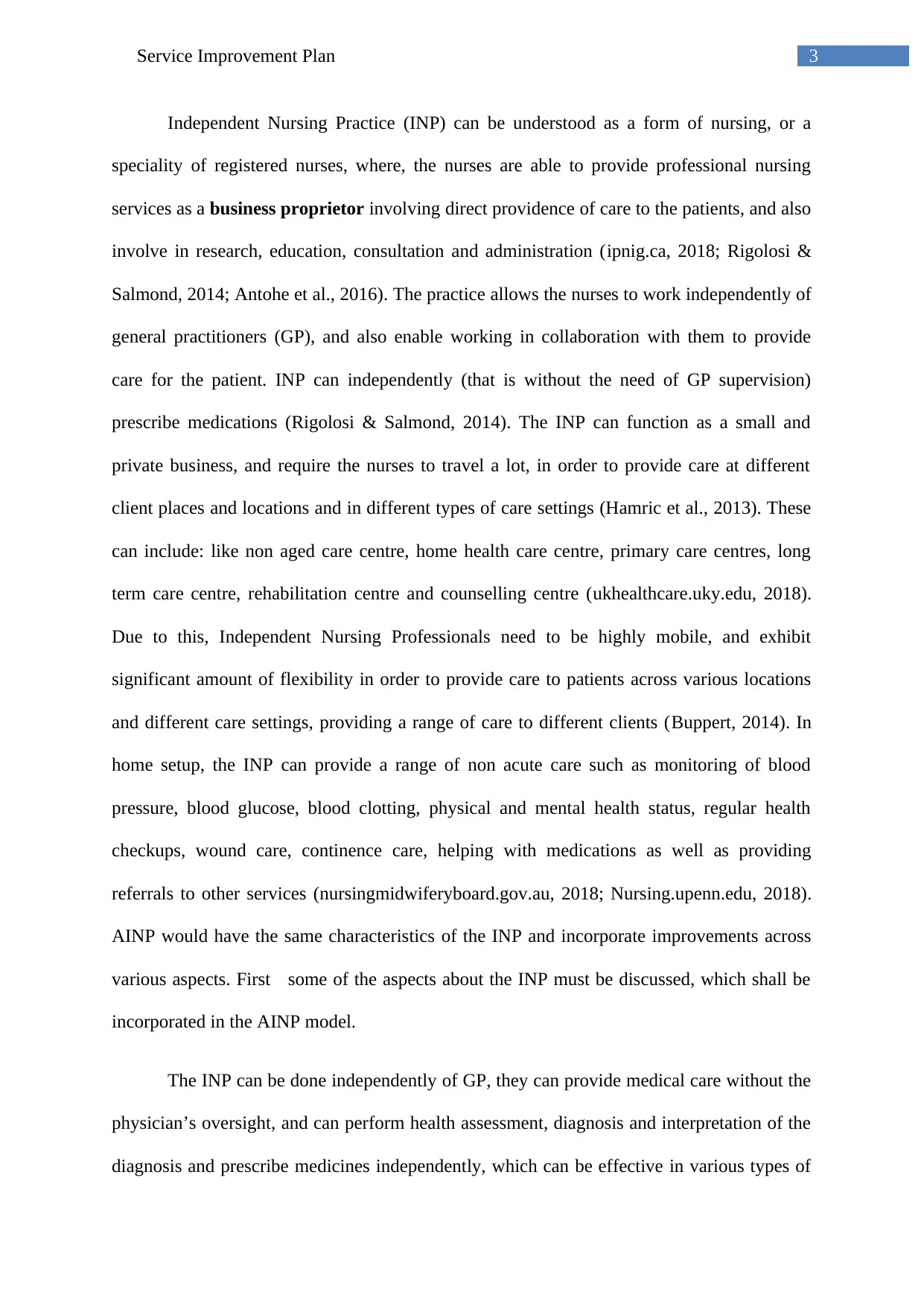
3Service Improvement Plan
Independent Nursing Practice (INP) can be understood as a form of nursing, or a
speciality of registered nurses, where, the nurses are able to provide professional nursing
services as a business proprietor involving direct providence of care to the patients, and also
involve in research, education, consultation and administration (ipnig.ca, 2018; Rigolosi &
Salmond, 2014; Antohe et al., 2016). The practice allows the nurses to work independently of
general practitioners (GP), and also enable working in collaboration with them to provide
care for the patient. INP can independently (that is without the need of GP supervision)
prescribe medications (Rigolosi & Salmond, 2014). The INP can function as a small and
private business, and require the nurses to travel a lot, in order to provide care at different
client places and locations and in different types of care settings (Hamric et al., 2013). These
can include: like non aged care centre, home health care centre, primary care centres, long
term care centre, rehabilitation centre and counselling centre (ukhealthcare.uky.edu, 2018).
Due to this, Independent Nursing Professionals need to be highly mobile, and exhibit
significant amount of flexibility in order to provide care to patients across various locations
and different care settings, providing a range of care to different clients (Buppert, 2014). In
home setup, the INP can provide a range of non acute care such as monitoring of blood
pressure, blood glucose, blood clotting, physical and mental health status, regular health
checkups, wound care, continence care, helping with medications as well as providing
referrals to other services (nursingmidwiferyboard.gov.au, 2018; Nursing.upenn.edu, 2018).
AINP would have the same characteristics of the INP and incorporate improvements across
various aspects. First some of the aspects about the INP must be discussed, which shall be
incorporated in the AINP model.
The INP can be done independently of GP, they can provide medical care without the
physician’s oversight, and can perform health assessment, diagnosis and interpretation of the
diagnosis and prescribe medicines independently, which can be effective in various types of
Independent Nursing Practice (INP) can be understood as a form of nursing, or a
speciality of registered nurses, where, the nurses are able to provide professional nursing
services as a business proprietor involving direct providence of care to the patients, and also
involve in research, education, consultation and administration (ipnig.ca, 2018; Rigolosi &
Salmond, 2014; Antohe et al., 2016). The practice allows the nurses to work independently of
general practitioners (GP), and also enable working in collaboration with them to provide
care for the patient. INP can independently (that is without the need of GP supervision)
prescribe medications (Rigolosi & Salmond, 2014). The INP can function as a small and
private business, and require the nurses to travel a lot, in order to provide care at different
client places and locations and in different types of care settings (Hamric et al., 2013). These
can include: like non aged care centre, home health care centre, primary care centres, long
term care centre, rehabilitation centre and counselling centre (ukhealthcare.uky.edu, 2018).
Due to this, Independent Nursing Professionals need to be highly mobile, and exhibit
significant amount of flexibility in order to provide care to patients across various locations
and different care settings, providing a range of care to different clients (Buppert, 2014). In
home setup, the INP can provide a range of non acute care such as monitoring of blood
pressure, blood glucose, blood clotting, physical and mental health status, regular health
checkups, wound care, continence care, helping with medications as well as providing
referrals to other services (nursingmidwiferyboard.gov.au, 2018; Nursing.upenn.edu, 2018).
AINP would have the same characteristics of the INP and incorporate improvements across
various aspects. First some of the aspects about the INP must be discussed, which shall be
incorporated in the AINP model.
The INP can be done independently of GP, they can provide medical care without the
physician’s oversight, and can perform health assessment, diagnosis and interpretation of the
diagnosis and prescribe medicines independently, which can be effective in various types of
Paraphrase This Document
Need a fresh take? Get an instant paraphrase of this document with our AI Paraphraser
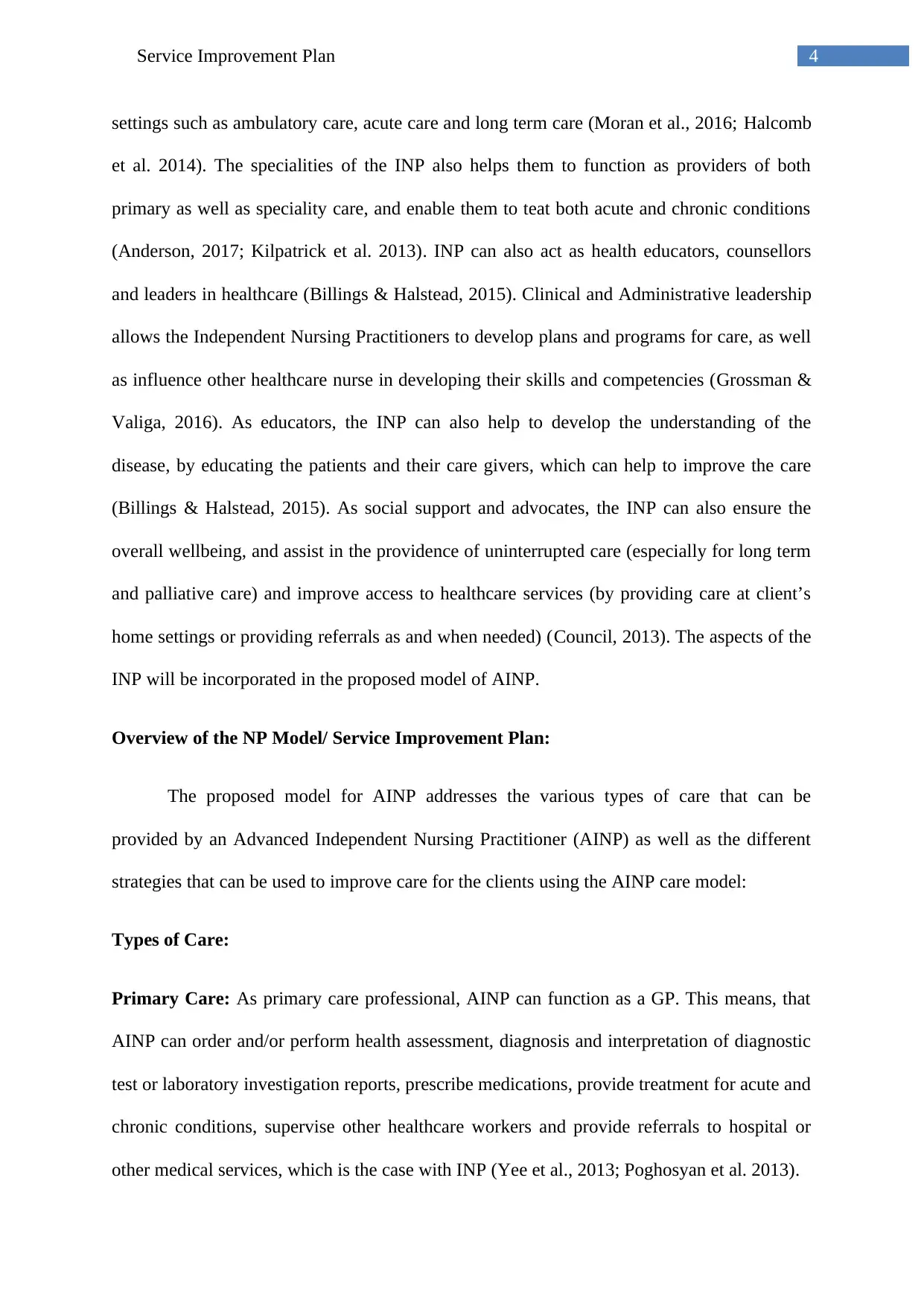
4Service Improvement Plan
settings such as ambulatory care, acute care and long term care (Moran et al., 2016; Halcomb
et al. 2014). The specialities of the INP also helps them to function as providers of both
primary as well as speciality care, and enable them to teat both acute and chronic conditions
(Anderson, 2017; Kilpatrick et al. 2013). INP can also act as health educators, counsellors
and leaders in healthcare (Billings & Halstead, 2015). Clinical and Administrative leadership
allows the Independent Nursing Practitioners to develop plans and programs for care, as well
as influence other healthcare nurse in developing their skills and competencies (Grossman &
Valiga, 2016). As educators, the INP can also help to develop the understanding of the
disease, by educating the patients and their care givers, which can help to improve the care
(Billings & Halstead, 2015). As social support and advocates, the INP can also ensure the
overall wellbeing, and assist in the providence of uninterrupted care (especially for long term
and palliative care) and improve access to healthcare services (by providing care at client’s
home settings or providing referrals as and when needed) (Council, 2013). The aspects of the
INP will be incorporated in the proposed model of AINP.
Overview of the NP Model/ Service Improvement Plan:
The proposed model for AINP addresses the various types of care that can be
provided by an Advanced Independent Nursing Practitioner (AINP) as well as the different
strategies that can be used to improve care for the clients using the AINP care model:
Types of Care:
Primary Care: As primary care professional, AINP can function as a GP. This means, that
AINP can order and/or perform health assessment, diagnosis and interpretation of diagnostic
test or laboratory investigation reports, prescribe medications, provide treatment for acute and
chronic conditions, supervise other healthcare workers and provide referrals to hospital or
other medical services, which is the case with INP (Yee et al., 2013; Poghosyan et al. 2013).
settings such as ambulatory care, acute care and long term care (Moran et al., 2016; Halcomb
et al. 2014). The specialities of the INP also helps them to function as providers of both
primary as well as speciality care, and enable them to teat both acute and chronic conditions
(Anderson, 2017; Kilpatrick et al. 2013). INP can also act as health educators, counsellors
and leaders in healthcare (Billings & Halstead, 2015). Clinical and Administrative leadership
allows the Independent Nursing Practitioners to develop plans and programs for care, as well
as influence other healthcare nurse in developing their skills and competencies (Grossman &
Valiga, 2016). As educators, the INP can also help to develop the understanding of the
disease, by educating the patients and their care givers, which can help to improve the care
(Billings & Halstead, 2015). As social support and advocates, the INP can also ensure the
overall wellbeing, and assist in the providence of uninterrupted care (especially for long term
and palliative care) and improve access to healthcare services (by providing care at client’s
home settings or providing referrals as and when needed) (Council, 2013). The aspects of the
INP will be incorporated in the proposed model of AINP.
Overview of the NP Model/ Service Improvement Plan:
The proposed model for AINP addresses the various types of care that can be
provided by an Advanced Independent Nursing Practitioner (AINP) as well as the different
strategies that can be used to improve care for the clients using the AINP care model:
Types of Care:
Primary Care: As primary care professional, AINP can function as a GP. This means, that
AINP can order and/or perform health assessment, diagnosis and interpretation of diagnostic
test or laboratory investigation reports, prescribe medications, provide treatment for acute and
chronic conditions, supervise other healthcare workers and provide referrals to hospital or
other medical services, which is the case with INP (Yee et al., 2013; Poghosyan et al. 2013).
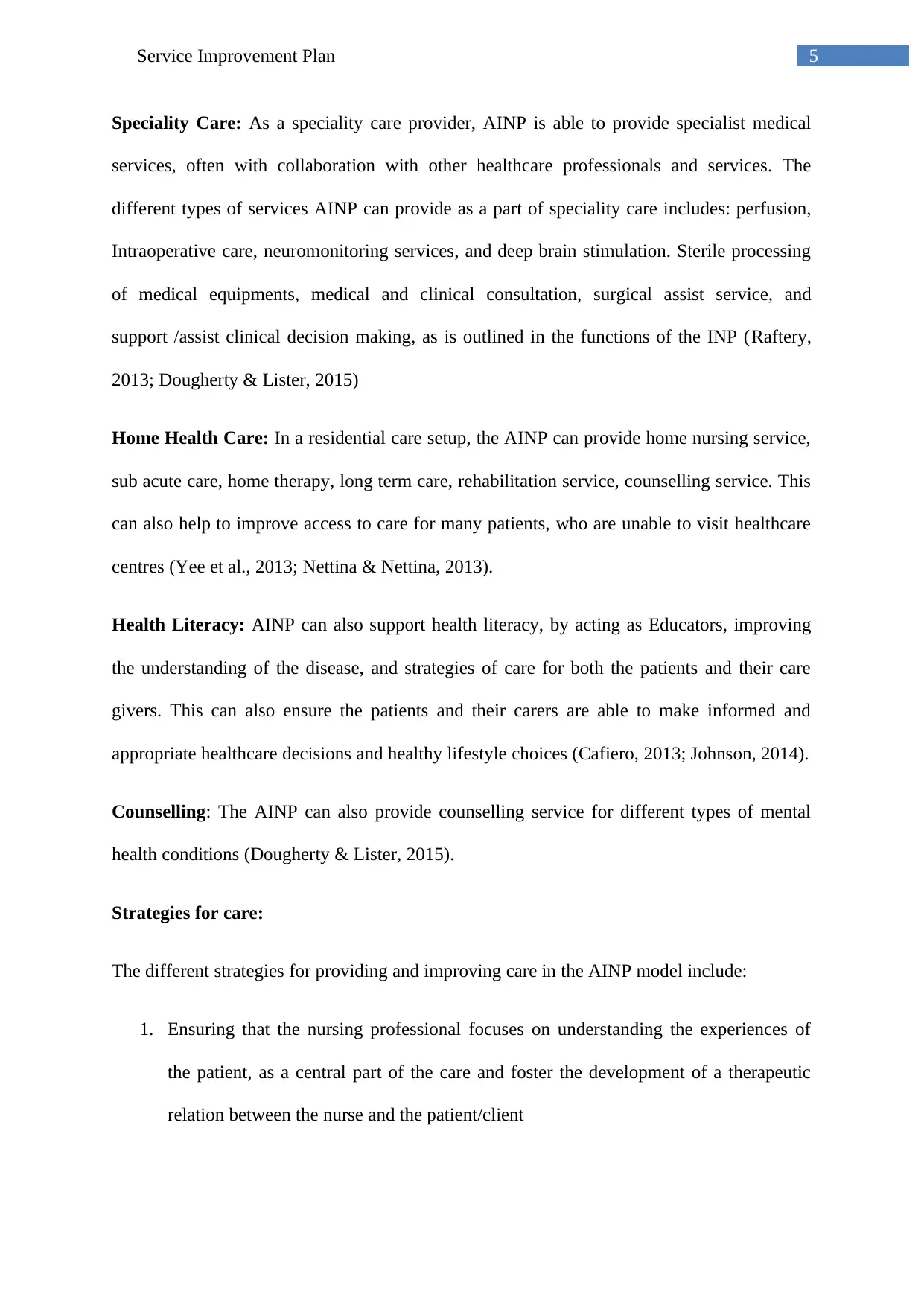
5Service Improvement Plan
Speciality Care: As a speciality care provider, AINP is able to provide specialist medical
services, often with collaboration with other healthcare professionals and services. The
different types of services AINP can provide as a part of speciality care includes: perfusion,
Intraoperative care, neuromonitoring services, and deep brain stimulation. Sterile processing
of medical equipments, medical and clinical consultation, surgical assist service, and
support /assist clinical decision making, as is outlined in the functions of the INP (Raftery,
2013; Dougherty & Lister, 2015)
Home Health Care: In a residential care setup, the AINP can provide home nursing service,
sub acute care, home therapy, long term care, rehabilitation service, counselling service. This
can also help to improve access to care for many patients, who are unable to visit healthcare
centres (Yee et al., 2013; Nettina & Nettina, 2013).
Health Literacy: AINP can also support health literacy, by acting as Educators, improving
the understanding of the disease, and strategies of care for both the patients and their care
givers. This can also ensure the patients and their carers are able to make informed and
appropriate healthcare decisions and healthy lifestyle choices (Cafiero, 2013; Johnson, 2014).
Counselling: The AINP can also provide counselling service for different types of mental
health conditions (Dougherty & Lister, 2015).
Strategies for care:
The different strategies for providing and improving care in the AINP model include:
1. Ensuring that the nursing professional focuses on understanding the experiences of
the patient, as a central part of the care and foster the development of a therapeutic
relation between the nurse and the patient/client
Speciality Care: As a speciality care provider, AINP is able to provide specialist medical
services, often with collaboration with other healthcare professionals and services. The
different types of services AINP can provide as a part of speciality care includes: perfusion,
Intraoperative care, neuromonitoring services, and deep brain stimulation. Sterile processing
of medical equipments, medical and clinical consultation, surgical assist service, and
support /assist clinical decision making, as is outlined in the functions of the INP (Raftery,
2013; Dougherty & Lister, 2015)
Home Health Care: In a residential care setup, the AINP can provide home nursing service,
sub acute care, home therapy, long term care, rehabilitation service, counselling service. This
can also help to improve access to care for many patients, who are unable to visit healthcare
centres (Yee et al., 2013; Nettina & Nettina, 2013).
Health Literacy: AINP can also support health literacy, by acting as Educators, improving
the understanding of the disease, and strategies of care for both the patients and their care
givers. This can also ensure the patients and their carers are able to make informed and
appropriate healthcare decisions and healthy lifestyle choices (Cafiero, 2013; Johnson, 2014).
Counselling: The AINP can also provide counselling service for different types of mental
health conditions (Dougherty & Lister, 2015).
Strategies for care:
The different strategies for providing and improving care in the AINP model include:
1. Ensuring that the nursing professional focuses on understanding the experiences of
the patient, as a central part of the care and foster the development of a therapeutic
relation between the nurse and the patient/client
⊘ This is a preview!⊘
Do you want full access?
Subscribe today to unlock all pages.

Trusted by 1+ million students worldwide
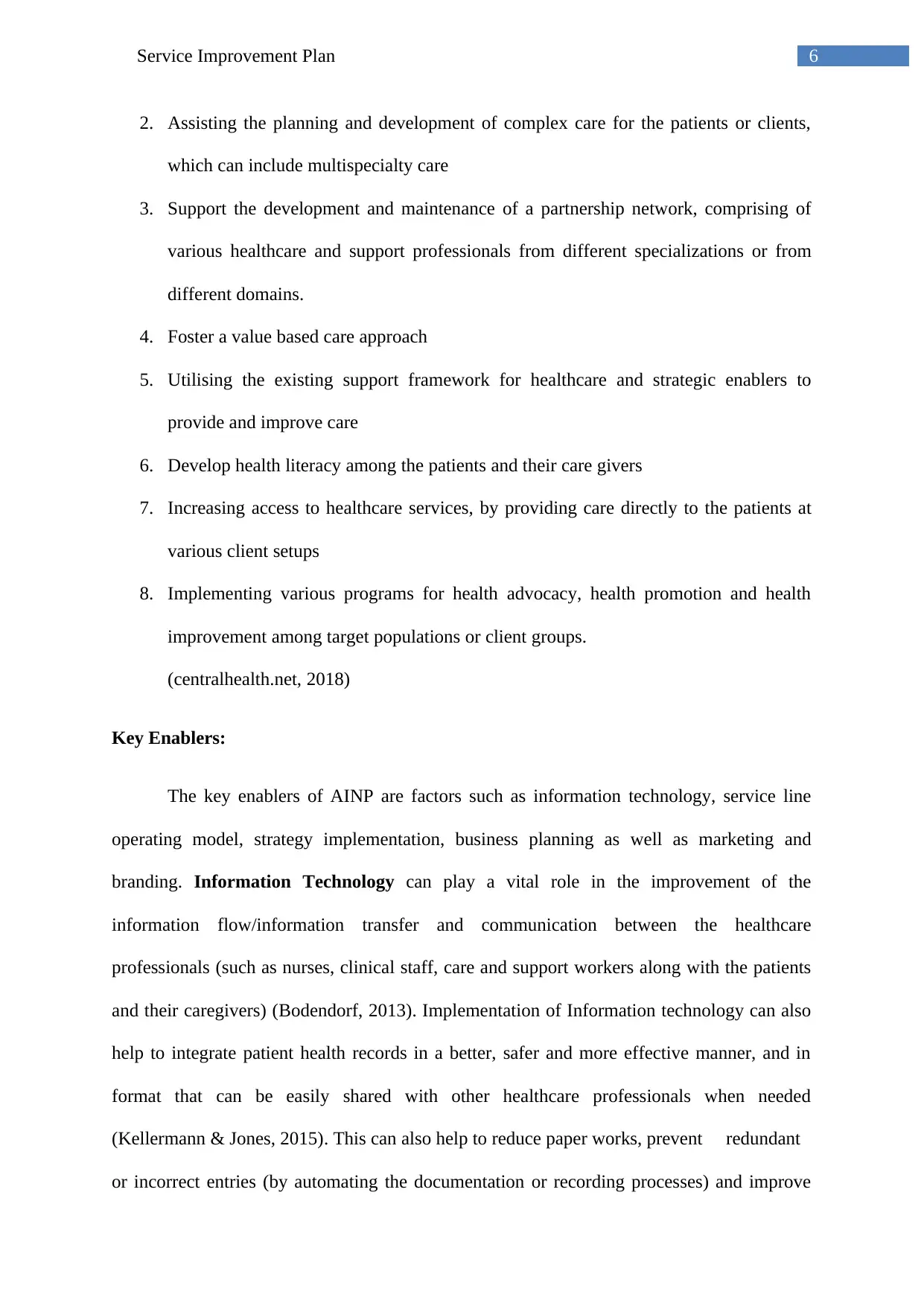
6Service Improvement Plan
2. Assisting the planning and development of complex care for the patients or clients,
which can include multispecialty care
3. Support the development and maintenance of a partnership network, comprising of
various healthcare and support professionals from different specializations or from
different domains.
4. Foster a value based care approach
5. Utilising the existing support framework for healthcare and strategic enablers to
provide and improve care
6. Develop health literacy among the patients and their care givers
7. Increasing access to healthcare services, by providing care directly to the patients at
various client setups
8. Implementing various programs for health advocacy, health promotion and health
improvement among target populations or client groups.
(centralhealth.net, 2018)
Key Enablers:
The key enablers of AINP are factors such as information technology, service line
operating model, strategy implementation, business planning as well as marketing and
branding. Information Technology can play a vital role in the improvement of the
information flow/information transfer and communication between the healthcare
professionals (such as nurses, clinical staff, care and support workers along with the patients
and their caregivers) (Bodendorf, 2013). Implementation of Information technology can also
help to integrate patient health records in a better, safer and more effective manner, and in
format that can be easily shared with other healthcare professionals when needed
(Kellermann & Jones, 2015). This can also help to reduce paper works, prevent redundant
or incorrect entries (by automating the documentation or recording processes) and improve
2. Assisting the planning and development of complex care for the patients or clients,
which can include multispecialty care
3. Support the development and maintenance of a partnership network, comprising of
various healthcare and support professionals from different specializations or from
different domains.
4. Foster a value based care approach
5. Utilising the existing support framework for healthcare and strategic enablers to
provide and improve care
6. Develop health literacy among the patients and their care givers
7. Increasing access to healthcare services, by providing care directly to the patients at
various client setups
8. Implementing various programs for health advocacy, health promotion and health
improvement among target populations or client groups.
(centralhealth.net, 2018)
Key Enablers:
The key enablers of AINP are factors such as information technology, service line
operating model, strategy implementation, business planning as well as marketing and
branding. Information Technology can play a vital role in the improvement of the
information flow/information transfer and communication between the healthcare
professionals (such as nurses, clinical staff, care and support workers along with the patients
and their caregivers) (Bodendorf, 2013). Implementation of Information technology can also
help to integrate patient health records in a better, safer and more effective manner, and in
format that can be easily shared with other healthcare professionals when needed
(Kellermann & Jones, 2015). This can also help to reduce paper works, prevent redundant
or incorrect entries (by automating the documentation or recording processes) and improve
Paraphrase This Document
Need a fresh take? Get an instant paraphrase of this document with our AI Paraphraser
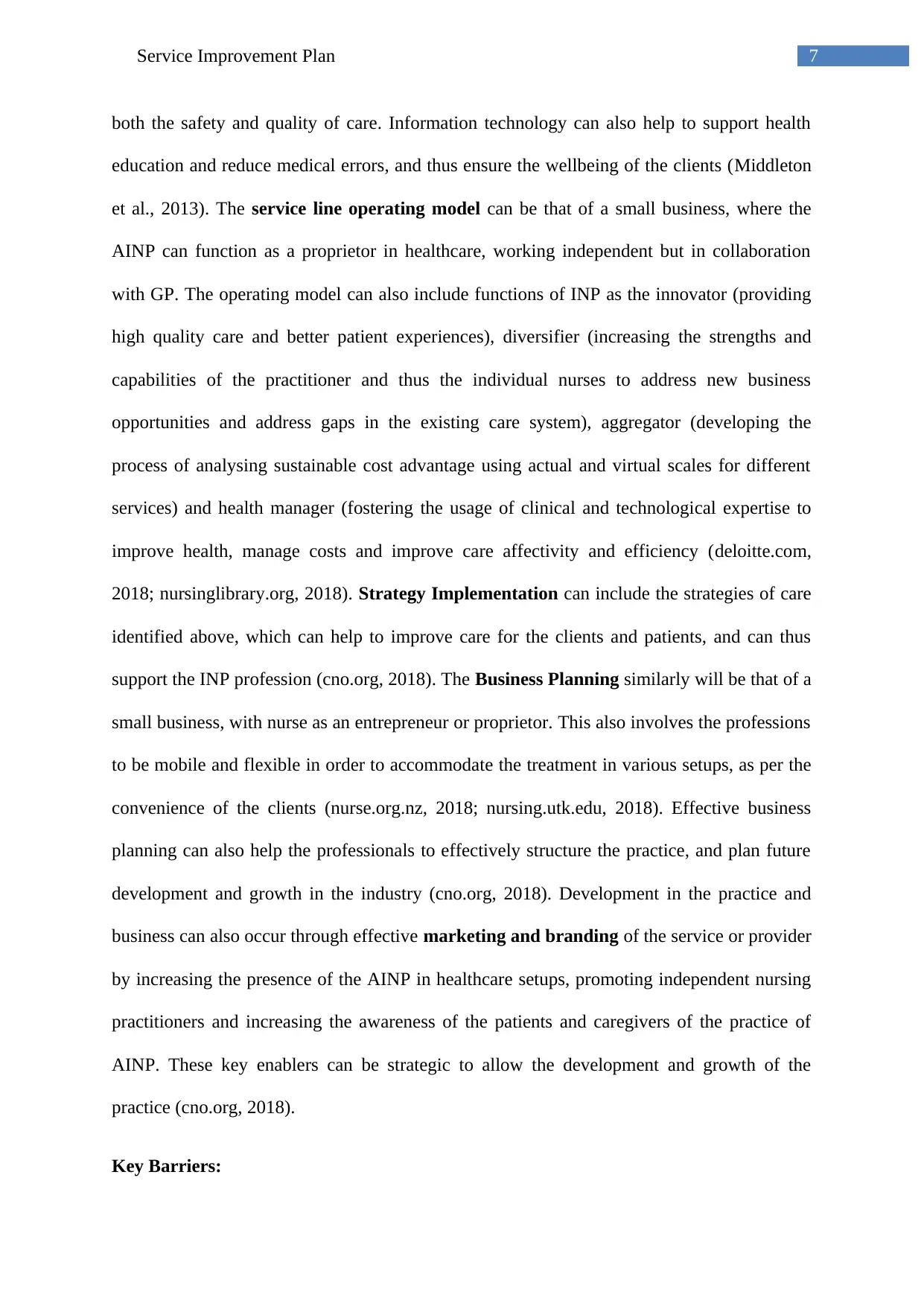
7Service Improvement Plan
both the safety and quality of care. Information technology can also help to support health
education and reduce medical errors, and thus ensure the wellbeing of the clients (Middleton
et al., 2013). The service line operating model can be that of a small business, where the
AINP can function as a proprietor in healthcare, working independent but in collaboration
with GP. The operating model can also include functions of INP as the innovator (providing
high quality care and better patient experiences), diversifier (increasing the strengths and
capabilities of the practitioner and thus the individual nurses to address new business
opportunities and address gaps in the existing care system), aggregator (developing the
process of analysing sustainable cost advantage using actual and virtual scales for different
services) and health manager (fostering the usage of clinical and technological expertise to
improve health, manage costs and improve care affectivity and efficiency (deloitte.com,
2018; nursinglibrary.org, 2018). Strategy Implementation can include the strategies of care
identified above, which can help to improve care for the clients and patients, and can thus
support the INP profession (cno.org, 2018). The Business Planning similarly will be that of a
small business, with nurse as an entrepreneur or proprietor. This also involves the professions
to be mobile and flexible in order to accommodate the treatment in various setups, as per the
convenience of the clients (nurse.org.nz, 2018; nursing.utk.edu, 2018). Effective business
planning can also help the professionals to effectively structure the practice, and plan future
development and growth in the industry (cno.org, 2018). Development in the practice and
business can also occur through effective marketing and branding of the service or provider
by increasing the presence of the AINP in healthcare setups, promoting independent nursing
practitioners and increasing the awareness of the patients and caregivers of the practice of
AINP. These key enablers can be strategic to allow the development and growth of the
practice (cno.org, 2018).
Key Barriers:
both the safety and quality of care. Information technology can also help to support health
education and reduce medical errors, and thus ensure the wellbeing of the clients (Middleton
et al., 2013). The service line operating model can be that of a small business, where the
AINP can function as a proprietor in healthcare, working independent but in collaboration
with GP. The operating model can also include functions of INP as the innovator (providing
high quality care and better patient experiences), diversifier (increasing the strengths and
capabilities of the practitioner and thus the individual nurses to address new business
opportunities and address gaps in the existing care system), aggregator (developing the
process of analysing sustainable cost advantage using actual and virtual scales for different
services) and health manager (fostering the usage of clinical and technological expertise to
improve health, manage costs and improve care affectivity and efficiency (deloitte.com,
2018; nursinglibrary.org, 2018). Strategy Implementation can include the strategies of care
identified above, which can help to improve care for the clients and patients, and can thus
support the INP profession (cno.org, 2018). The Business Planning similarly will be that of a
small business, with nurse as an entrepreneur or proprietor. This also involves the professions
to be mobile and flexible in order to accommodate the treatment in various setups, as per the
convenience of the clients (nurse.org.nz, 2018; nursing.utk.edu, 2018). Effective business
planning can also help the professionals to effectively structure the practice, and plan future
development and growth in the industry (cno.org, 2018). Development in the practice and
business can also occur through effective marketing and branding of the service or provider
by increasing the presence of the AINP in healthcare setups, promoting independent nursing
practitioners and increasing the awareness of the patients and caregivers of the practice of
AINP. These key enablers can be strategic to allow the development and growth of the
practice (cno.org, 2018).
Key Barriers:
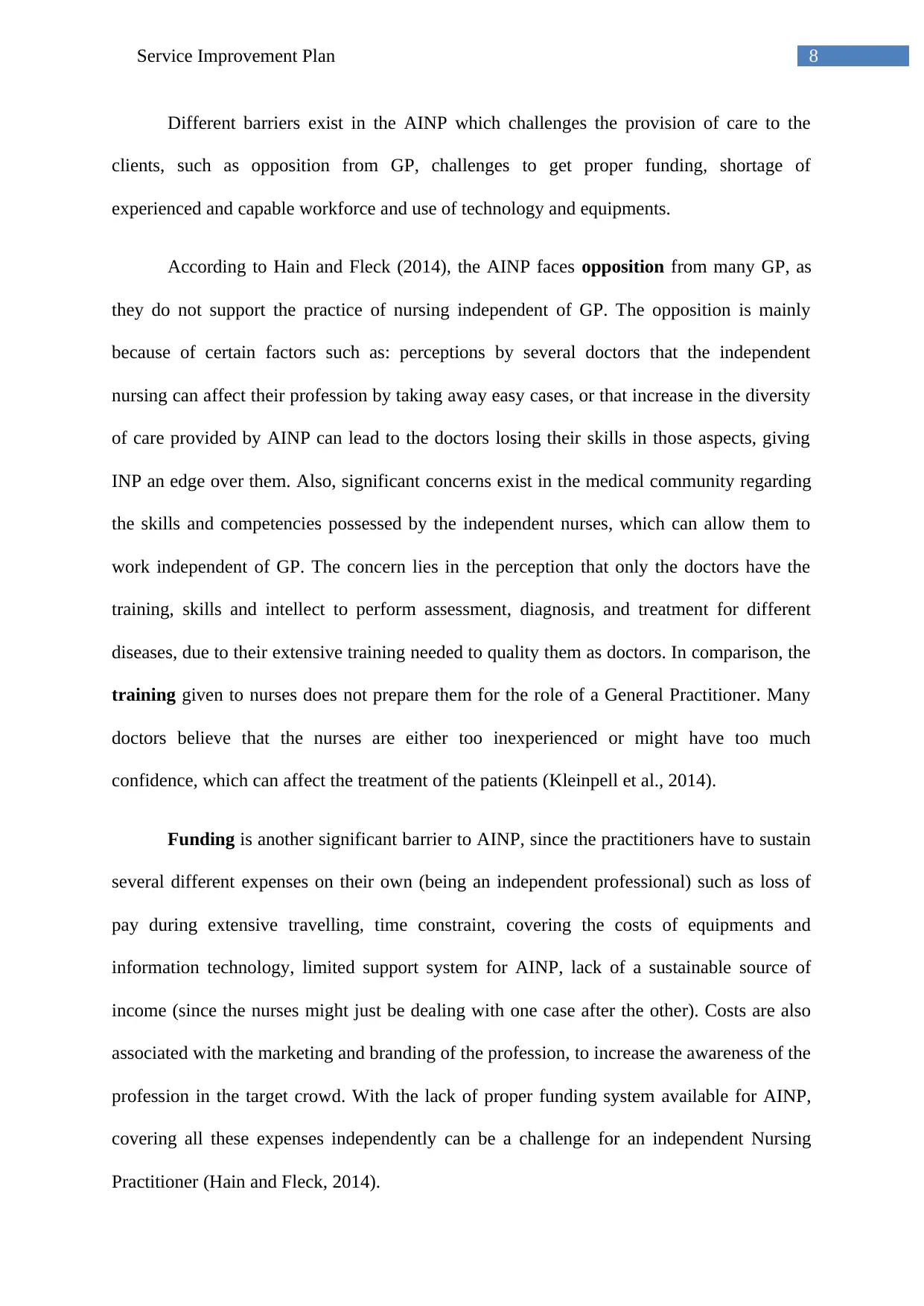
8Service Improvement Plan
Different barriers exist in the AINP which challenges the provision of care to the
clients, such as opposition from GP, challenges to get proper funding, shortage of
experienced and capable workforce and use of technology and equipments.
According to Hain and Fleck (2014), the AINP faces opposition from many GP, as
they do not support the practice of nursing independent of GP. The opposition is mainly
because of certain factors such as: perceptions by several doctors that the independent
nursing can affect their profession by taking away easy cases, or that increase in the diversity
of care provided by AINP can lead to the doctors losing their skills in those aspects, giving
INP an edge over them. Also, significant concerns exist in the medical community regarding
the skills and competencies possessed by the independent nurses, which can allow them to
work independent of GP. The concern lies in the perception that only the doctors have the
training, skills and intellect to perform assessment, diagnosis, and treatment for different
diseases, due to their extensive training needed to quality them as doctors. In comparison, the
training given to nurses does not prepare them for the role of a General Practitioner. Many
doctors believe that the nurses are either too inexperienced or might have too much
confidence, which can affect the treatment of the patients (Kleinpell et al., 2014).
Funding is another significant barrier to AINP, since the practitioners have to sustain
several different expenses on their own (being an independent professional) such as loss of
pay during extensive travelling, time constraint, covering the costs of equipments and
information technology, limited support system for AINP, lack of a sustainable source of
income (since the nurses might just be dealing with one case after the other). Costs are also
associated with the marketing and branding of the profession, to increase the awareness of the
profession in the target crowd. With the lack of proper funding system available for AINP,
covering all these expenses independently can be a challenge for an independent Nursing
Practitioner (Hain and Fleck, 2014).
Different barriers exist in the AINP which challenges the provision of care to the
clients, such as opposition from GP, challenges to get proper funding, shortage of
experienced and capable workforce and use of technology and equipments.
According to Hain and Fleck (2014), the AINP faces opposition from many GP, as
they do not support the practice of nursing independent of GP. The opposition is mainly
because of certain factors such as: perceptions by several doctors that the independent
nursing can affect their profession by taking away easy cases, or that increase in the diversity
of care provided by AINP can lead to the doctors losing their skills in those aspects, giving
INP an edge over them. Also, significant concerns exist in the medical community regarding
the skills and competencies possessed by the independent nurses, which can allow them to
work independent of GP. The concern lies in the perception that only the doctors have the
training, skills and intellect to perform assessment, diagnosis, and treatment for different
diseases, due to their extensive training needed to quality them as doctors. In comparison, the
training given to nurses does not prepare them for the role of a General Practitioner. Many
doctors believe that the nurses are either too inexperienced or might have too much
confidence, which can affect the treatment of the patients (Kleinpell et al., 2014).
Funding is another significant barrier to AINP, since the practitioners have to sustain
several different expenses on their own (being an independent professional) such as loss of
pay during extensive travelling, time constraint, covering the costs of equipments and
information technology, limited support system for AINP, lack of a sustainable source of
income (since the nurses might just be dealing with one case after the other). Costs are also
associated with the marketing and branding of the profession, to increase the awareness of the
profession in the target crowd. With the lack of proper funding system available for AINP,
covering all these expenses independently can be a challenge for an independent Nursing
Practitioner (Hain and Fleck, 2014).
⊘ This is a preview!⊘
Do you want full access?
Subscribe today to unlock all pages.

Trusted by 1+ million students worldwide
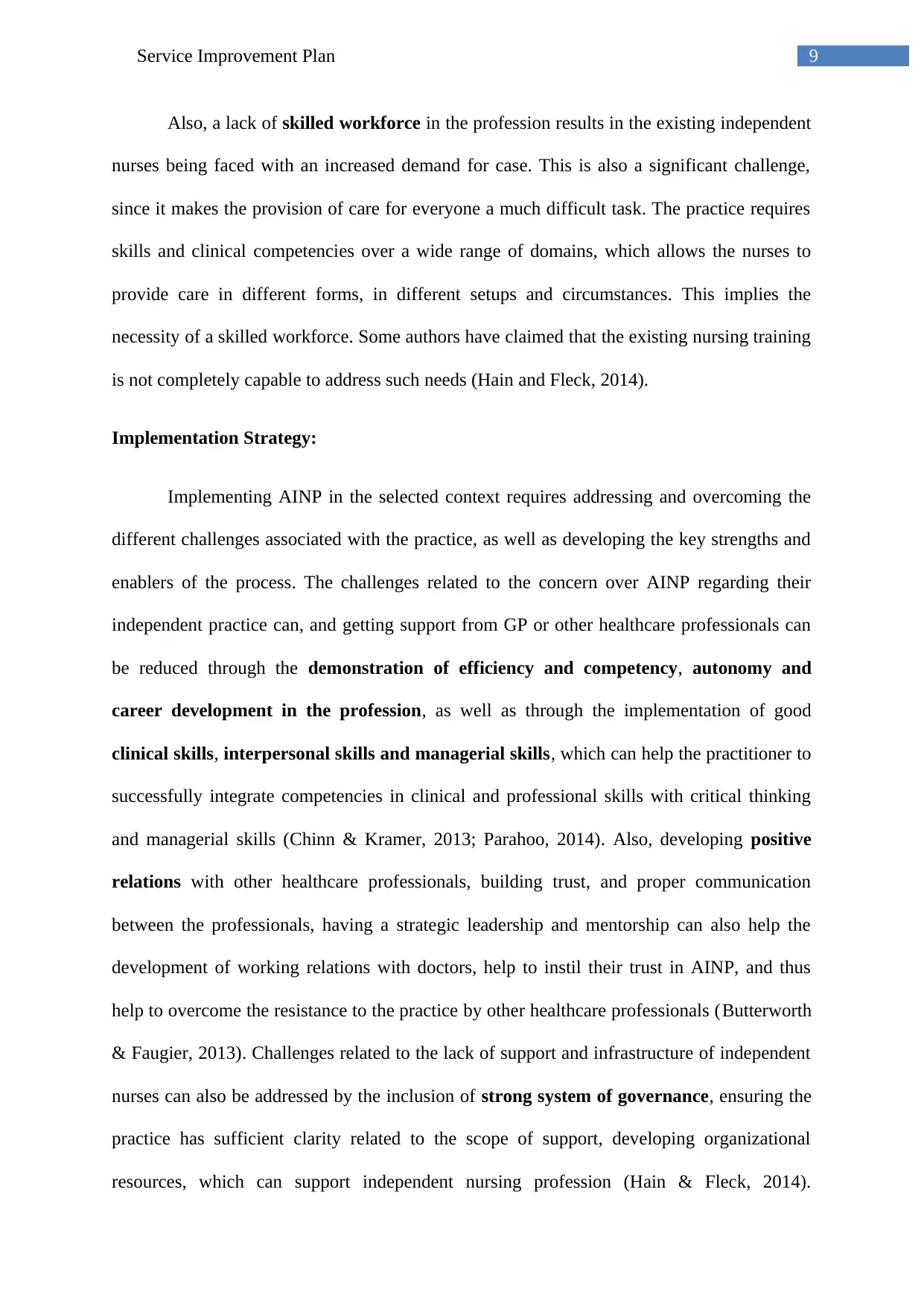
9Service Improvement Plan
Also, a lack of skilled workforce in the profession results in the existing independent
nurses being faced with an increased demand for case. This is also a significant challenge,
since it makes the provision of care for everyone a much difficult task. The practice requires
skills and clinical competencies over a wide range of domains, which allows the nurses to
provide care in different forms, in different setups and circumstances. This implies the
necessity of a skilled workforce. Some authors have claimed that the existing nursing training
is not completely capable to address such needs (Hain and Fleck, 2014).
Implementation Strategy:
Implementing AINP in the selected context requires addressing and overcoming the
different challenges associated with the practice, as well as developing the key strengths and
enablers of the process. The challenges related to the concern over AINP regarding their
independent practice can, and getting support from GP or other healthcare professionals can
be reduced through the demonstration of efficiency and competency, autonomy and
career development in the profession, as well as through the implementation of good
clinical skills, interpersonal skills and managerial skills, which can help the practitioner to
successfully integrate competencies in clinical and professional skills with critical thinking
and managerial skills (Chinn & Kramer, 2013; Parahoo, 2014). Also, developing positive
relations with other healthcare professionals, building trust, and proper communication
between the professionals, having a strategic leadership and mentorship can also help the
development of working relations with doctors, help to instil their trust in AINP, and thus
help to overcome the resistance to the practice by other healthcare professionals (Butterworth
& Faugier, 2013). Challenges related to the lack of support and infrastructure of independent
nurses can also be addressed by the inclusion of strong system of governance, ensuring the
practice has sufficient clarity related to the scope of support, developing organizational
resources, which can support independent nursing profession (Hain & Fleck, 2014).
Also, a lack of skilled workforce in the profession results in the existing independent
nurses being faced with an increased demand for case. This is also a significant challenge,
since it makes the provision of care for everyone a much difficult task. The practice requires
skills and clinical competencies over a wide range of domains, which allows the nurses to
provide care in different forms, in different setups and circumstances. This implies the
necessity of a skilled workforce. Some authors have claimed that the existing nursing training
is not completely capable to address such needs (Hain and Fleck, 2014).
Implementation Strategy:
Implementing AINP in the selected context requires addressing and overcoming the
different challenges associated with the practice, as well as developing the key strengths and
enablers of the process. The challenges related to the concern over AINP regarding their
independent practice can, and getting support from GP or other healthcare professionals can
be reduced through the demonstration of efficiency and competency, autonomy and
career development in the profession, as well as through the implementation of good
clinical skills, interpersonal skills and managerial skills, which can help the practitioner to
successfully integrate competencies in clinical and professional skills with critical thinking
and managerial skills (Chinn & Kramer, 2013; Parahoo, 2014). Also, developing positive
relations with other healthcare professionals, building trust, and proper communication
between the professionals, having a strategic leadership and mentorship can also help the
development of working relations with doctors, help to instil their trust in AINP, and thus
help to overcome the resistance to the practice by other healthcare professionals (Butterworth
& Faugier, 2013). Challenges related to the lack of support and infrastructure of independent
nurses can also be addressed by the inclusion of strong system of governance, ensuring the
practice has sufficient clarity related to the scope of support, developing organizational
resources, which can support independent nursing profession (Hain & Fleck, 2014).
Paraphrase This Document
Need a fresh take? Get an instant paraphrase of this document with our AI Paraphraser
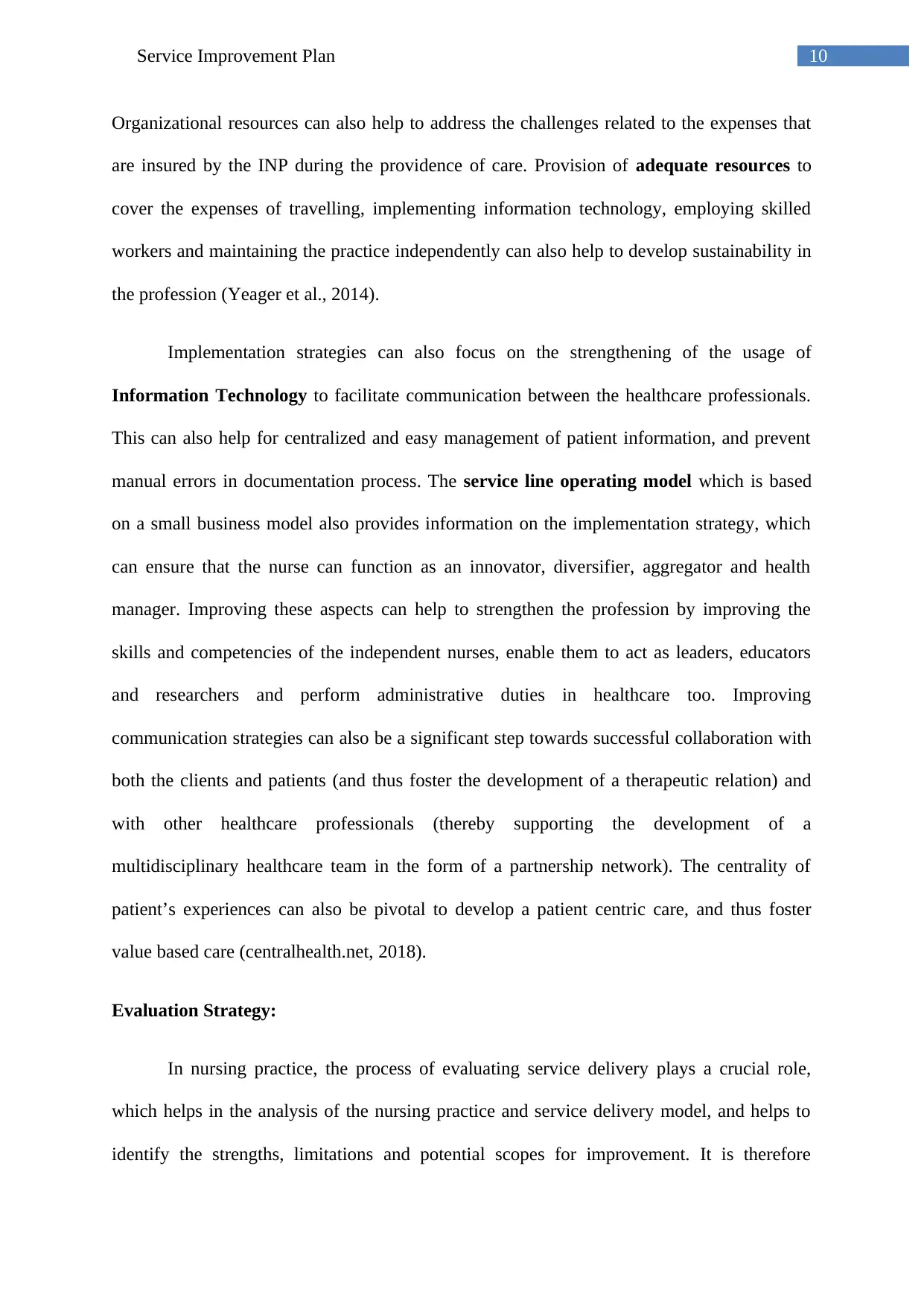
10Service Improvement Plan
Organizational resources can also help to address the challenges related to the expenses that
are insured by the INP during the providence of care. Provision of adequate resources to
cover the expenses of travelling, implementing information technology, employing skilled
workers and maintaining the practice independently can also help to develop sustainability in
the profession (Yeager et al., 2014).
Implementation strategies can also focus on the strengthening of the usage of
Information Technology to facilitate communication between the healthcare professionals.
This can also help for centralized and easy management of patient information, and prevent
manual errors in documentation process. The service line operating model which is based
on a small business model also provides information on the implementation strategy, which
can ensure that the nurse can function as an innovator, diversifier, aggregator and health
manager. Improving these aspects can help to strengthen the profession by improving the
skills and competencies of the independent nurses, enable them to act as leaders, educators
and researchers and perform administrative duties in healthcare too. Improving
communication strategies can also be a significant step towards successful collaboration with
both the clients and patients (and thus foster the development of a therapeutic relation) and
with other healthcare professionals (thereby supporting the development of a
multidisciplinary healthcare team in the form of a partnership network). The centrality of
patient’s experiences can also be pivotal to develop a patient centric care, and thus foster
value based care (centralhealth.net, 2018).
Evaluation Strategy:
In nursing practice, the process of evaluating service delivery plays a crucial role,
which helps in the analysis of the nursing practice and service delivery model, and helps to
identify the strengths, limitations and potential scopes for improvement. It is therefore
Organizational resources can also help to address the challenges related to the expenses that
are insured by the INP during the providence of care. Provision of adequate resources to
cover the expenses of travelling, implementing information technology, employing skilled
workers and maintaining the practice independently can also help to develop sustainability in
the profession (Yeager et al., 2014).
Implementation strategies can also focus on the strengthening of the usage of
Information Technology to facilitate communication between the healthcare professionals.
This can also help for centralized and easy management of patient information, and prevent
manual errors in documentation process. The service line operating model which is based
on a small business model also provides information on the implementation strategy, which
can ensure that the nurse can function as an innovator, diversifier, aggregator and health
manager. Improving these aspects can help to strengthen the profession by improving the
skills and competencies of the independent nurses, enable them to act as leaders, educators
and researchers and perform administrative duties in healthcare too. Improving
communication strategies can also be a significant step towards successful collaboration with
both the clients and patients (and thus foster the development of a therapeutic relation) and
with other healthcare professionals (thereby supporting the development of a
multidisciplinary healthcare team in the form of a partnership network). The centrality of
patient’s experiences can also be pivotal to develop a patient centric care, and thus foster
value based care (centralhealth.net, 2018).
Evaluation Strategy:
In nursing practice, the process of evaluating service delivery plays a crucial role,
which helps in the analysis of the nursing practice and service delivery model, and helps to
identify the strengths, limitations and potential scopes for improvement. It is therefore
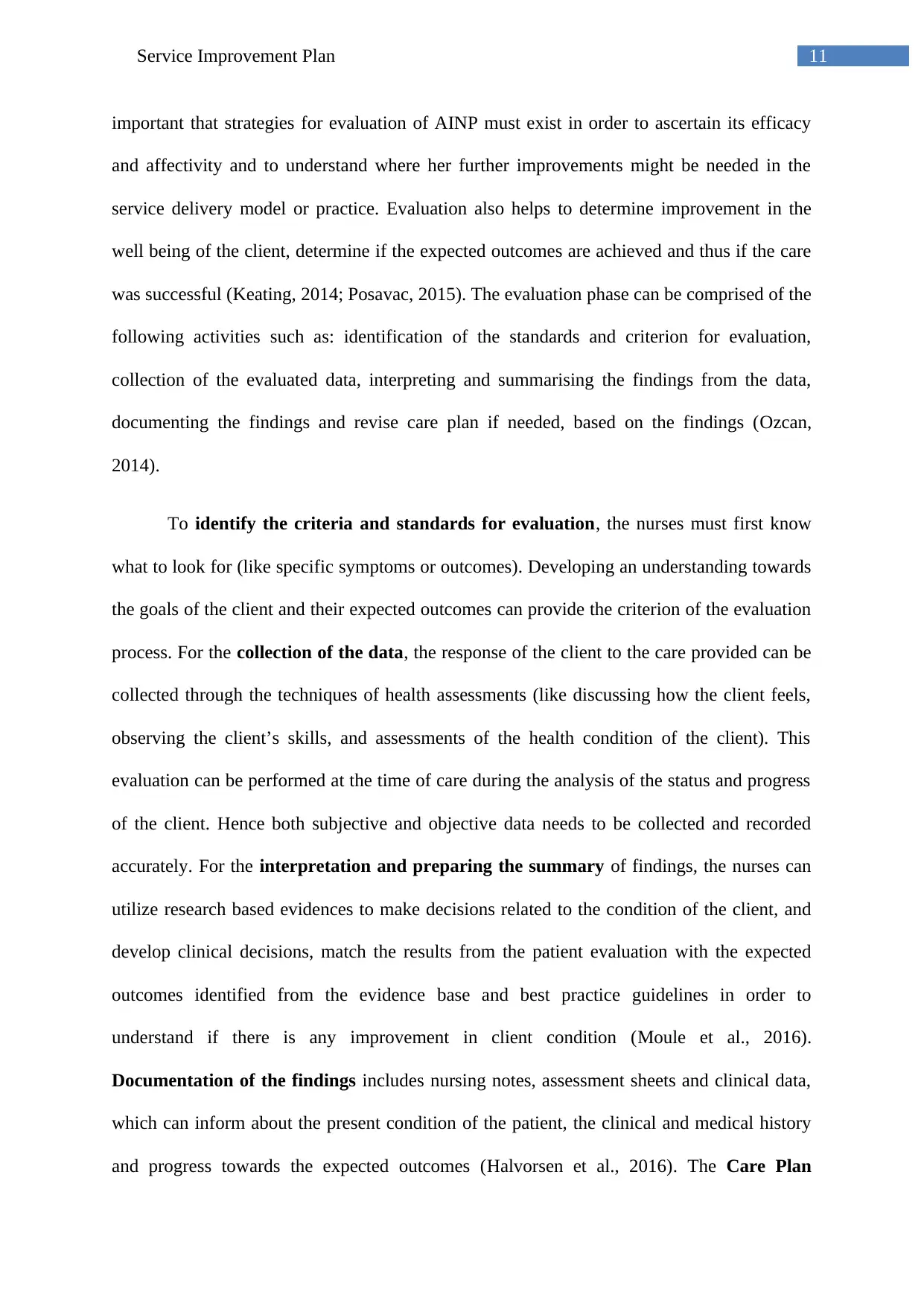
11Service Improvement Plan
important that strategies for evaluation of AINP must exist in order to ascertain its efficacy
and affectivity and to understand where her further improvements might be needed in the
service delivery model or practice. Evaluation also helps to determine improvement in the
well being of the client, determine if the expected outcomes are achieved and thus if the care
was successful (Keating, 2014; Posavac, 2015). The evaluation phase can be comprised of the
following activities such as: identification of the standards and criterion for evaluation,
collection of the evaluated data, interpreting and summarising the findings from the data,
documenting the findings and revise care plan if needed, based on the findings (Ozcan,
2014).
To identify the criteria and standards for evaluation, the nurses must first know
what to look for (like specific symptoms or outcomes). Developing an understanding towards
the goals of the client and their expected outcomes can provide the criterion of the evaluation
process. For the collection of the data, the response of the client to the care provided can be
collected through the techniques of health assessments (like discussing how the client feels,
observing the client’s skills, and assessments of the health condition of the client). This
evaluation can be performed at the time of care during the analysis of the status and progress
of the client. Hence both subjective and objective data needs to be collected and recorded
accurately. For the interpretation and preparing the summary of findings, the nurses can
utilize research based evidences to make decisions related to the condition of the client, and
develop clinical decisions, match the results from the patient evaluation with the expected
outcomes identified from the evidence base and best practice guidelines in order to
understand if there is any improvement in client condition (Moule et al., 2016).
Documentation of the findings includes nursing notes, assessment sheets and clinical data,
which can inform about the present condition of the patient, the clinical and medical history
and progress towards the expected outcomes (Halvorsen et al., 2016). The Care Plan
important that strategies for evaluation of AINP must exist in order to ascertain its efficacy
and affectivity and to understand where her further improvements might be needed in the
service delivery model or practice. Evaluation also helps to determine improvement in the
well being of the client, determine if the expected outcomes are achieved and thus if the care
was successful (Keating, 2014; Posavac, 2015). The evaluation phase can be comprised of the
following activities such as: identification of the standards and criterion for evaluation,
collection of the evaluated data, interpreting and summarising the findings from the data,
documenting the findings and revise care plan if needed, based on the findings (Ozcan,
2014).
To identify the criteria and standards for evaluation, the nurses must first know
what to look for (like specific symptoms or outcomes). Developing an understanding towards
the goals of the client and their expected outcomes can provide the criterion of the evaluation
process. For the collection of the data, the response of the client to the care provided can be
collected through the techniques of health assessments (like discussing how the client feels,
observing the client’s skills, and assessments of the health condition of the client). This
evaluation can be performed at the time of care during the analysis of the status and progress
of the client. Hence both subjective and objective data needs to be collected and recorded
accurately. For the interpretation and preparing the summary of findings, the nurses can
utilize research based evidences to make decisions related to the condition of the client, and
develop clinical decisions, match the results from the patient evaluation with the expected
outcomes identified from the evidence base and best practice guidelines in order to
understand if there is any improvement in client condition (Moule et al., 2016).
Documentation of the findings includes nursing notes, assessment sheets and clinical data,
which can inform about the present condition of the patient, the clinical and medical history
and progress towards the expected outcomes (Halvorsen et al., 2016). The Care Plan
⊘ This is a preview!⊘
Do you want full access?
Subscribe today to unlock all pages.

Trusted by 1+ million students worldwide
1 out of 21
Related Documents
Your All-in-One AI-Powered Toolkit for Academic Success.
+13062052269
info@desklib.com
Available 24*7 on WhatsApp / Email
![[object Object]](/_next/static/media/star-bottom.7253800d.svg)
Unlock your academic potential
Copyright © 2020–2025 A2Z Services. All Rights Reserved. Developed and managed by ZUCOL.





